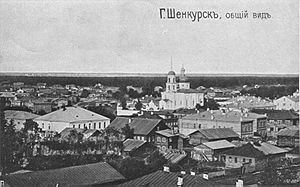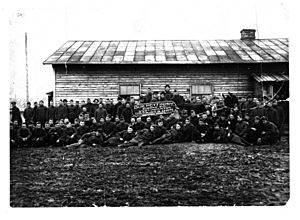Battle of Shenkursk facts for kids
Quick facts for kids Battle of Shenkursk |
|||||||
|---|---|---|---|---|---|---|---|
| Part of the Allied North Russia Intervention during the Russian Civil War | |||||||
 A panoramic view of Shenkursk in 1917 |
|||||||
|
|||||||
| Belligerents | |||||||
| Commanders and leaders | |||||||
| Strength | |||||||
|
According to Soviet data: According to American data: |
According to Soviet data: According to American data: |
||||||
| Casualties and losses | |||||||
| According to Soviet data: 15 guns 60 machine guns 2,000 rifles According to American data: ~39 killed ~100 wounded |
~1 killed Unknown wounded |
||||||
The Battle of Shenkursk happened in January 1919 during the Russian Civil War. This war was a big fight in Russia after the Bolshevik Revolution. The battle was part of the North Russia intervention, where countries like the United States and the United Kingdom sent troops to help fight against the Bolsheviks (also known as the Red Army).
After the Red Army lost a battle at Tulgas, they decided to attack the town of Shenkursk. This town was important because it was on the Vaga River. The Allied forces defending Shenkursk included soldiers from the United States, the United Kingdom, and Russian troops who were against the Bolsheviks (called White Russians). The battle ended with the Allied forces having to leave Shenkursk because the Bolshevik army was much stronger.
Contents
What Happened at the Battle of Shenkursk?
Most of the Allied soldiers protecting the Vaga River were from Company A of the United States Army's 339th Infantry Regiment. Otto Odjard, an American Captain, led about 200 of his men. He also commanded about 900 British and White Russian soldiers.
Captain Odjard's main base was in Shenkursk. However, most of the American troops, along with two large cannons, were in a nearby village called Vysokaya Gora. A smaller group of 47 Americans, led by Lieutenant Harry Mead, was stationed about 18 miles south in the village of Nizhnyaya Gora. Close by, in Ust Padenga, were some White Russian Cossacks (a type of soldier).
The Attack on Nizhnyaya Gora
On January 19, at sunrise, Bolshevik cannons suddenly started firing heavily on Nizhnyaya Gora. After an hour, the shelling stopped. Then, about 1,000 Bolshevik soldiers charged into the village with their bayonets (knives attached to rifles).
Lieutenant Mead knew his small group had to retreat. He called Captain Odjard to tell him. Odjard ordered Mead to keep fighting as long as possible. He promised that the cannons in Vysokaya Gora would help cover their retreat. The Americans started shooting as the Bolsheviks got closer. A group of Cossacks arrived but quickly left after their officer was hurt.
Finally, Mead ordered his men to pull back. But the main street was covered by enemy machine gun fire. This meant going that way would be very dangerous. Mead later wrote about how they had to march down a hill, across an open valley. It was covered in deep snow, and they were under direct enemy fire. There was no place to hide. Many men were hurt or died in the snow from wounds or the cold. The Americans did not get the cannon support they were promised. The White Russian gunners had left their posts. By the time Captain Odjard forced them back, it was too late to help Mead's retreating troops.
Fighting at Vysokaya Gora
Only seven of the 47 American soldiers, including Lieutenant Mead, made it to Vysokaya Gora. The Bolsheviks did not attack right away. This allowed the Americans to rescue many of their wounded. By evening, 19 Americans were still missing, and six were known to have died. Two more Americans showed up that night. They had hidden in a Russian house before sneaking past the Bolsheviks.
That same night, Lieutenant Douglas Winslow arrived from Shenkursk. He brought Canadian soldiers to take over the two cannons from the White Russians who had left earlier. The Cossack company also moved from Ust Padenga to Vysokaya Gora without the Bolsheviks noticing.
For the next three days, the Americans, though greatly outnumbered, defended Vysokaya Gora. They fought against repeated attacks from over 3,000 enemy soldiers. The fighting involved many small battles. The Russians then started using snipers to shoot at the American lines instead of charging. The snipers caused more injuries to the Allied soldiers. Also, shrapnel from repeated cannon attacks hurt many. On January 20 and 21, the Bolsheviks attacked again and again. They lost many soldiers because of the Canadian cannons. They took over the empty village of Ust Padenga but could not get into Vysokaya Gora.
On the evening of January 22, orders came to leave Vysokaya Gora. As the Allies began to retreat, a Soviet incendiary round (a type of fire-starting bullet) hit the town and set it on fire. One of the two Canadian cannons fell into a ditch. The soldiers had to break the gun so the enemy could not use it, and then leave it behind.
The Allied soldiers reached the village of Sholosha at 7 AM on January 23. They rested briefly before moving to Spasskoe, which was four miles from Shenkursk. They planned to fight there to slow down the enemy. When they arrived, Captain O. A. Mowat of the Canadian artillery met them. He had a group of men and one cannon. (The other cannon from Vysokaya Gora had already been sent to Shenkursk.)
On the morning of January 24, the Soviets started firing cannons at the Allies in Spasskoe. In the afternoon, Captain Mowat was hit by a shell and badly hurt. He was taken to the Shenkursk hospital, where he later died. Later that day, a Soviet shell hit the last remaining cannon, destroying it. A gunner was killed, and Captain Odjard was injured. He was also taken to Shenkursk. The Allied Lieutenants decided they could not hold Spasskoe without cannons. So, they ordered a retreat to Shenkursk.
The Retreat from Shenkursk
By 4 PM on January 24, the remaining soldiers of Company A reached Shenkursk. Some Americans were so tired from fighting that they fell asleep right away. The Red Army was close behind them. They surrounded Shenkursk, planning to attack the next morning.
Captain Odjard, who was wounded, asked his commanding officer, British General Edmund Ironside, for instructions. General Ironside ordered Odjard to leave Shenkursk before his troops were destroyed. There was only one way to escape that the Bolsheviks had not blocked. It was an old logging trail that went north through the forest towards the village of Vystavka. So, at midnight on January 24, the soldiers left Shenkursk.
About 100 of the most seriously wounded soldiers left first. They were put on sleds pulled by horses. Those who could walk marched on foot. Captain Odjard worried that the Bolsheviks might have snipers along the trail. But there were none, and the soldiers successfully escaped Shenkursk without the enemy knowing.
The battle was over at this point. The last shots heard were from Bolshevik cannons shelling Shenkursk at 8:00 AM on January 25. They did not know the Allies had already left. When the soldiers finally reached Vystavka on January 27, they built defenses. They then fought off several Red Army attacks over the next few weeks. This battle was important for the Bolsheviks. By pushing the Allies north, they stopped them from launching new attacks or joining with a large White Russian army coming from Siberia. Instead, the Allies had to defend Vystavka.


